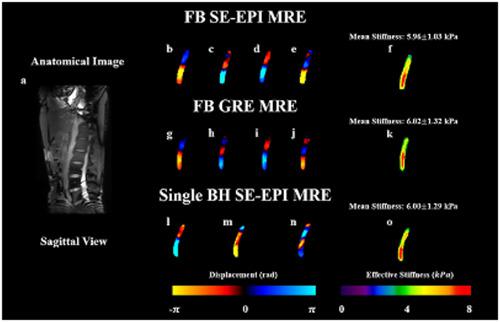当前位置:
X-MOL 学术
›
NMR Biomed.
›
论文详情
Our official English website, www.x-mol.net, welcomes your
feedback! (Note: you will need to create a separate account there.)
Magnetic resonance elastography for estimating in vivo stiffness of the abdominal aorta using cardiac‐gated spin‐echo echo‐planar imaging: a feasibility study
NMR in Biomedicine ( IF 2.7 ) Pub Date : 2020-10-06 , DOI: 10.1002/nbm.4420 Huiming Dong 1, 2 , Ning Jin 3 , Stephan Kannengiesser 4 , Brian Raterman 1 , Richard D White 1, 2, 5 , Arunark Kolipaka 1, 2, 5
NMR in Biomedicine ( IF 2.7 ) Pub Date : 2020-10-06 , DOI: 10.1002/nbm.4420 Huiming Dong 1, 2 , Ning Jin 3 , Stephan Kannengiesser 4 , Brian Raterman 1 , Richard D White 1, 2, 5 , Arunark Kolipaka 1, 2, 5
Affiliation

|
Magnetic resonance elastography (MRE)‐derived aortic stiffness is a potential biomarker for multiple cardiovascular diseases. Currently, gradient‐recalled echo (GRE) MRE is a widely accepted technique to estimate aortic stiffness. However, multi‐slice GRE MRE requires multiple breath‐holds (BHs), which can be challenging for patients who cannot consistently hold their breath. The aim of this study was to investigate the feasibility of a multi‐slice spin‐echo echo‐planar imaging (SE‐EPI) MRE sequence for quantifying in vivo aortic stiffness using a free‐breathing (FB) protocol and a single‐BH protocol.
中文翻译:

使用心脏门控自旋回波平面成像估计腹主动脉体内硬度的磁共振弹性成像:一项可行性研究
磁共振弹性成像(MRE)衍生的主动脉僵硬度是多种心血管疾病的潜在生物标志物。目前,梯度召回回波 (GRE) MRE 是一种被广泛接受的估计主动脉僵硬度的技术。然而,多层 GRE MRE 需要多次屏气 (BH),这对于不能一直屏住呼吸的患者来说可能具有挑战性。本研究的目的是研究多切片自旋回波回波平面成像 (SE-EPI) MRE 序列用于使用自由呼吸 (FB) 协议和单 BH 协议量化体内主动脉僵硬度的可行性。 .
更新日期:2020-12-08
中文翻译:

使用心脏门控自旋回波平面成像估计腹主动脉体内硬度的磁共振弹性成像:一项可行性研究
磁共振弹性成像(MRE)衍生的主动脉僵硬度是多种心血管疾病的潜在生物标志物。目前,梯度召回回波 (GRE) MRE 是一种被广泛接受的估计主动脉僵硬度的技术。然而,多层 GRE MRE 需要多次屏气 (BH),这对于不能一直屏住呼吸的患者来说可能具有挑战性。本研究的目的是研究多切片自旋回波回波平面成像 (SE-EPI) MRE 序列用于使用自由呼吸 (FB) 协议和单 BH 协议量化体内主动脉僵硬度的可行性。 .











































 京公网安备 11010802027423号
京公网安备 11010802027423号